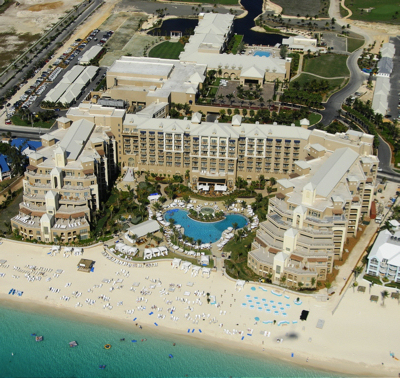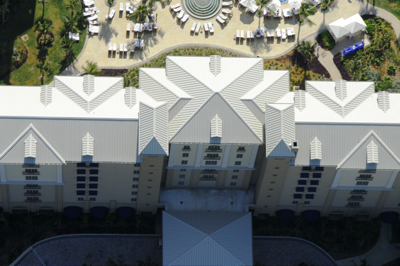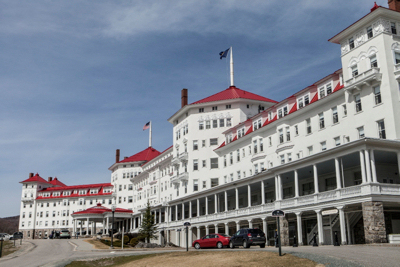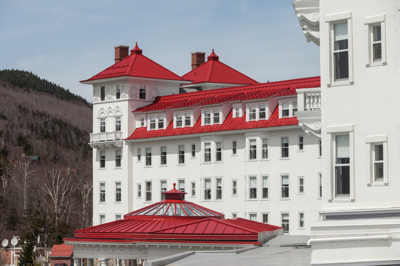With Good Reason, Metal Roofs Are Ideal For Today's Hotels
By Tony Newman, National Sales Manager, Englert Inc.
According to the latest numbers from the U.S. Census Bureau, there are more than 50,000 hotels in the United States, with more added every year. Due to concerns about rising maintenance costs, sustainability and branding, a lot of the new ones will wind up having metal roofs.

|
To withstand the effects of hurricane force winds, which can ruin a roof in the blink of an eye, and daily exposure to salt-laden air, which can degrade a roof slowly over time, the Magdalena Grand Island Beach Resort on the island of Tobago (shown above and below) was topped with a Kynar-finished, Series 2000 aluminum roof from Englert Inc. Aluminum is a preferred metal for projects in close proximity to the ocean. Click images to enlarge. | |

|
|

|
Shown above and below is another island resort hotel, this time the Ritz Carlton Grand Cayman in the Cayman Islands. It is topped with a Series 2500 standing seam roof from Englert. The system featured Kynar-finished panels formed from .040" aluminum. Click images above and below to enlarge. | |

|
|

|
At the Inn Of The Mountain Gods Resort and Casino in central New Mexico, shown above, salt air exposure was of no concern but good looks and long-term performance were. It was for those reasons that the sprawling complex was topped with 160,000 sq. ft. of jobsite rollformed Englert Series 1300 Galvalume-coated steel roof panels.
| |
Today’s hotels are designed to work 24/7. Downtime doesn’t exist in the hotel business. That’s what makes the roof so important. It represents only about 10 percent of a project’s total cost but is an essential element, protecting a critical asset that must deliver brand value and a solid return on investment, day in and day out, year after year. Architects, builders, developers and hotel operators should always be confident that their roofs will look good and protect their asset’s operations; every hour of the day, no matter what Mother Nature can throw at them. A standing seam metal roof provides that kind of protection and peace of mind.
A good standing seam metal roof is designed and warrantied to last for up to 35 years. When properly installed, neither snow, nor hurricane nor fire will affect it. With a metal roof, hotel operators don’t have to worry about closing down or cordoning off revenue-producing parts of their building to spare their guests the disturbances, noise and odors that are inevitable with flat roof repairs. Nor do they have to endure the impact of those repairs on the hotel’s image and profitability.
Maintenance-free performance is just one of the benefits metal roofing is bringing to today’s hotel developments. Metal is also an environmentally friendly choice.
Hotels are huge consumers of energy and water, and huge producers of waste. And they contribute to the production of greenhouse gases. Selecting sites for the next generation of hotels is fast becoming as much about effective management of the local water supply and energy resources as it is about pampering guests. Environmental laws and the forces of Mother Nature are dictating that green initiatives have to be adapted on a project-by-project basis to achieve the highest level of energy and waste controls.
Hospitality’s traditional focus has always been on the interior environment, purchasing bulk supplies of everything from food to amenities; installing energy-efficient fixtures, lighting, and appliances; and using low-VOC paints. Now, they are starting to look at the exterior of the building too, fitting properties with low-flow water fixtures, timed outdoor sprinklers, sensor-equipped and energy-efficient outdoor lighting and tinted windows to reduce air-conditioning requirements.
But no comprehensive approach to sustainable design would be complete without considering the roof. UltraCool standing seam roofs are Energy Star approved and LEED compliant, and they’re eligible for sustainability tax credits and incentives. Their energy efficiency, high recycled content and total recyclability allow “cool metal roofs” to qualify for points in the Energy Star and LEED programs. A standing seam roof with cool roof designation can directly earn up to nine LEED credits for energy savings, recycling, recyclability and reuse and up to seven credits indirectly for water efficiency and water reduction. Coated metal and aluminum have a rainwater collection efficiency of more than 95 percent, far higher than non-metallic roof surfaces. Their angled, smooth surfaces are highly receptive to the use of photovoltaic laminates. Metal roofing decks are ideal for installing thermal hot water heating systems. And the space beneath a metal roof is perfect for new hot air systems that rely on the roof as a heating and cooling resource.

|
| | New hotels aren't the only ones that can benefit from a new metal roof. In New Hampshire, the old tile roof of the Omni Mount Washington Resort--a century-old hotel listed as a National Historic Landmark--was replaced with a Series 1300 standing seam system from Englert Inc. The rugged Series 1300 system is Florida Building Code compliant and Dade County tested for wind uplift. Click images above and below to enlarge. |
 |
 |

|
Officials at one major global hotel chain have estimated in the past that by adopting sustainable practices, the company’s hotels can reduce their energy use by roughly five percent, successfully blending financial performance with environmental and social performance.
Others predict more resorts will find ways to create 100% sustainable loops for conserving water by purifying and re-circulating “black water.” Studies by the Texas Water Development Board show standing seam metal roofs have a better watershed rate than other forms of roofing. Concrete roofs lose an average of about 10%, and built-up tar and gravel roofs lose as much as 15%. Flat roofs can retain as much as half an inch. Asphalt roofing has a "collection efficiency" of about 85 percent while coated metal and aluminum have a collection efficiency of more than 95 percent. And a recent University of Texas study shows metal roofs superior to other forms of roofing in purity. Concrete or clay tiles and asphalt shingles are more likely than other materials to support the growth of mold, algae, bacteria and moss, which can potentially contaminate water supplies. Asphalt shingles may leach small amounts of petroleum compounds. And any contact with lead paint or copper and lead flashings could lead to an unacceptable concentration of heavy metals in the water.
Spas also will be conserving energy by tapping into other systems to heat water—whether geothermal sources or heat exchange technology. Solar thermal technology can be installed under a standing seam metal roof which acts as a component of the thermal system, radiating and providing heat to a grid work of purlins which hold the thermal system in place. The solar thermal system harvests solar energy as heat, whenever available, to offset the fossil fuels and electricity used for heating domestic hot water. The same thermal technology can be reversed in winter time, sending warm liquid back to a snow covered roof where the standing seam metal heats up, melting snow quickly and efficiently.
The goal among developers is to have a model that will get payback in eight years or less. In the world of metal roofing, eight years is a brief period of time. Twenty to 35 years from now a standing seam roof will still be delivering energy efficient resources and comfort, adding to a developer’s ROI. And that brings up the next reason why hotel developers should think metal. Color.
Color magnifies brand image. It establishes a signature look for a single structure or an entire chain. Without a doubt, no other roofing material can touch the color choices a metal roof offers an architect in the design process. In addition to more than 25 standard colors in the industry, metal roofing manufacturers with their own paint lines can create custom color roofs unique for the brand. And that color can enhance the dynamic of the total building and works in congruence with the colors of the façade, windows and ornamentation--all often brilliantly lit at night to reveal the architecture and convey emotion.
As an investment, as a brand builder and as a legitimate catalyst for environmental consciousness, a standing seam metal roof is by far, the most impactful solution to a hotel builder’s needs.
Because design decisions for hotels are often made with multiple locations in mind, hotel owners or senior chain executives responsible for architecture and construction can benefit greatly by establishing a relationship with a single roofing material manufacturer to supply materials and designate certified contractors in markets where new properties or major renovations to existing properties are being planned. Said manufacturer should be able to custom-tailor a roofing program to fit whatever the chain’s unique needs.
In terms of cost and specification, a good supplier should also be able to offer aggressive and consistent pricing across multiple locations, and provide labor-saving products that are performance tested and code compliant. Working with a single supplier is also the best way to ensure that projects from location to location maintain a consistent, uniform look, particularly where custom colors and panel designs are involved. Single sourcing can also eliminate the potential for mistakes at the design stage. Such mistakes are often the result of old specifications being recycled for new projects, or variations in the specs generated from one project to another, adversely affecting the quality standards from one project to the next.
Single-sourcing metal roof systems from a national supplier also gives the hotel operator – or his agent – a reliable resource to tap for design assistance, whether help is needed with the development of details, design calculations or the writing of those initial specifications. After all, the tighter the specification the lower the pricing will be for labor and materials, and the less likely the chance of construction conflicts resulting in change orders.
About Englert Inc.
 Englert Inc. is a developer of commercial and residential metal roofing and gutter systems, and supports a contractor network with the machinery and
materials to produce them on site. To learn more, visit www.englertinc.com.
Englert Inc. is a developer of commercial and residential metal roofing and gutter systems, and supports a contractor network with the machinery and
materials to produce them on site. To learn more, visit www.englertinc.com.